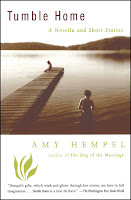This morning I received an alert for a new post in the blog The Green Study, by someone (Michelle) I don't personally know but whose musings I always find interesting, illuminating. In this installment she talks about how passé blogs are (according to, say, Substack, Instagram, and of course Twitter), and how she's fallen away from hers because of other activities—and yet she still finds value in the process.
Me too. I do this for myself. I don't expect anyone to look (though I do apparently have a few friends who do—and thank you: you know who you are). This is simply a place for me to dump some of the contents of my brain, some random experience or bit of learning, or those darn book reports, into a place where I might even be able to find it again. I'm not trying to sell anything, or convince anyone of anything, or do anything more than simply express an interest in life.
Today, for example, I read three articles mentioned on Facebook that I found interesting and wanted to keep track of:
"This Is America's Most-Wanted Painting": An
interesting discussion of, in this case, polling on what people want
(or don't want) in art—a conceptual art project by Alex Melamid and
Vitaly Komar from the 1990s. It also might be seen as an indictment of
polling as actually telling us anything that we should base our lives
on. (Think political polling, though that isn't covered here.)
"How Amy Tan Chose Flight over Environmental Fury," in Sierra magazine.
And Rebecca Solnit's "case for maps"—a simple FB post, but once it scrolls away, it's forever gone.So I'm putting them here, where I will no doubt keep stumbling on them. (I do look back over my posts, which are, astonishingly, forever fresh!)
And while I'm at it, I'm going to note the link to a New Yorker article my SIL recommended, "The Day the Dinosaurs Died."
Every time I throw out a stack of New Yorkers (they come every damn week; they stack up fast), I wonder what fascinating things I am throwing away, unconsumed, unacknowledged. But then of course, others will have read every single thing in those magazines, collectively. I envy them the richness they've acquired in doing so. I keep telling myself I should be more assiduous about reading our New Yorkers. David's good at it, though—they're his dinner-time reading—so they aren't going wasted.
And finally—because this, too, popped up today, and I want to stop and savor it at some point—here's Maria Popova's The Marginalian, focusing on an essay by Theodor Adorno, "Punctuation Marks."
Today, I could post photos of the awful flooding in Vancouver, B.C., which is currently cut off from the rest of Canada—reminding me of the time, years ago, Monterey Peninsula was cut off from the rest of the United States (though I only think of it as being cut off from the rest of the Central Coast), all roads leading out of the area being under water. Or I could talk about how yesterday we were caught in the middle of a high-speed car chase in the city of Soledad as we made our way to hike in Pinnacles National Park—only, of course, that story would be hyperbole, since we happened on the car chase only after the fact, thank goodness. Still, there were a huckuvalot of flashing lights and miles (okay, many, many yards) of yellow crime-scene tape, so it caught our attention, that's for sure.
But I can post a few photos from our hike yesterday, which was simply spectacular: a perfect day. Including all the condors we saw—and heard (they sound like jet engines when they plunge through the air). The condor photos aren't mine; they're from the National Park Service. But they need to be included.
 |
A turkey vulture and a condor:
note the size difference
|
And that's me today. Ain't life grand?
(Although that said, a good part of this post is occupied by climate change and endangered species, never mind planet-annihilating asteroids, so there's that.)



































































